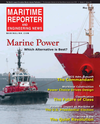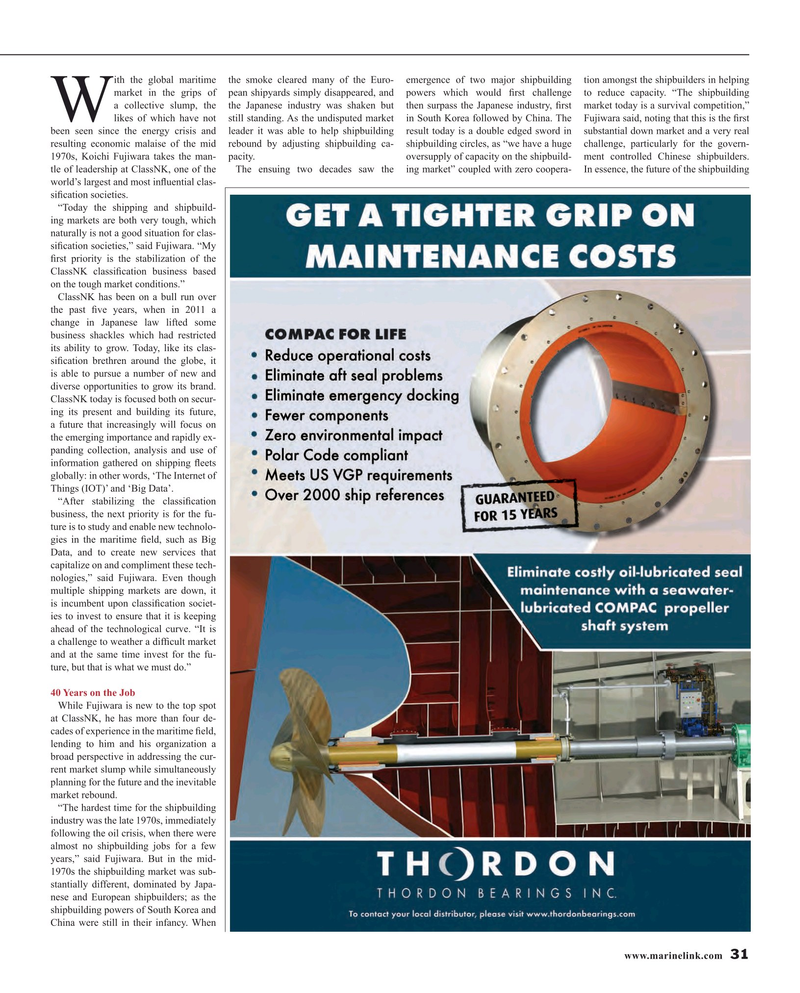
Page 31: of Maritime Reporter Magazine (May 2016)
The Marine Propulsion Edition
Read this page in Pdf, Flash or Html5 edition of May 2016 Maritime Reporter Magazine
ith the global maritime the smoke cleared many of the Euro- emergence of two major shipbuilding tion amongst the shipbuilders in helping market in the grips of pean shipyards simply disappeared, and powers which would ? rst challenge to reduce capacity. “The shipbuilding a collective slump, the the Japanese industry was shaken but then surpass the Japanese industry, ? rst market today is a survival competition,”
Wlikes of which have not still standing. As the undisputed market in South Korea followed by China. The Fujiwara said, noting that this is the ? rst been seen since the energy crisis and leader it was able to help shipbuilding result today is a double edged sword in substantial down market and a very real resulting economic malaise of the mid rebound by adjusting shipbuilding ca- shipbuilding circles, as “we have a huge challenge, particularly for the govern- 1970s, Koichi Fujiwara takes the man- pacity. oversupply of capacity on the shipbuild- ment controlled Chinese shipbuilders. tle of leadership at ClassNK, one of the The ensuing two decades saw the ing market” coupled with zero coopera- In essence, the future of the shipbuilding world’s largest and most in? uential clas- si? cation societies.
“Today the shipping and shipbuild- ing markets are both very tough, which naturally is not a good situation for clas- si? cation societies,” said Fujiwara. “My ? rst priority is the stabilization of the
ClassNK classi? cation business based on the tough market conditions.”
ClassNK has been on a bull run over the past ? ve years, when in 2011 a change in Japanese law lifted some business shackles which had restricted its ability to grow. Today, like its clas- si? cation brethren around the globe, it is able to pursue a number of new and diverse opportunities to grow its brand.
ClassNK today is focused both on secur- ing its present and building its future, a future that increasingly will focus on the emerging importance and rapidly ex- panding collection, analysis and use of information gathered on shipping ? eets globally: in other words, ‘The Internet of
Things (IOT)’ and ‘Big Data’.
“After stabilizing the classi? cation business, the next priority is for the fu- ture is to study and enable new technolo- gies in the maritime ? eld, such as Big
Data, and to create new services that capitalize on and compliment these tech- nologies,” said Fujiwara. Even though multiple shipping markets are down, it is incumbent upon classi? cation societ- ies to invest to ensure that it is keeping ahead of the technological curve. “It is a challenge to weather a dif? cult market and at the same time invest for the fu- ture, but that is what we must do.” 40 Years on the Job
While Fujiwara is new to the top spot at ClassNK, he has more than four de- cades of experience in the maritime ? eld, lending to him and his organization a broad perspective in addressing the cur- rent market slump while simultaneously planning for the future and the inevitable market rebound.
“The hardest time for the shipbuilding industry was the late 1970s, immediately following the oil crisis, when there were almost no shipbuilding jobs for a few years,” said Fujiwara. But in the mid- 1970s the shipbuilding market was sub- stantially different, dominated by Japa- nese and European shipbuilders; as the shipbuilding powers of South Korea and
China were still in their infancy. When www.marinelink.com 31
MR #5 (26-33).indd 31 5/3/2016 3:03:51 PM

 30
30

 32
32
